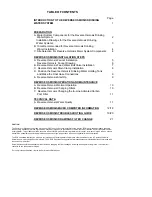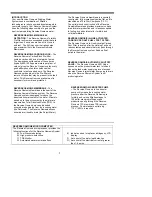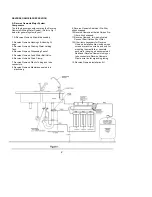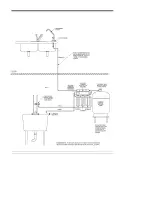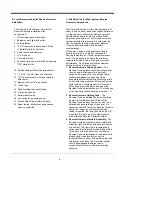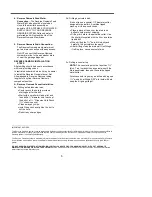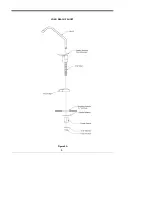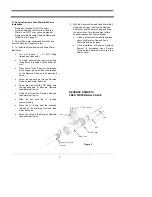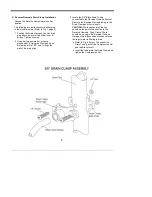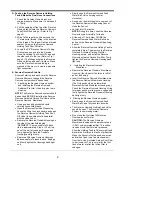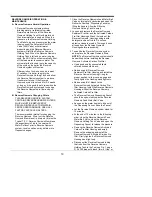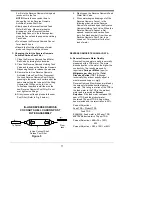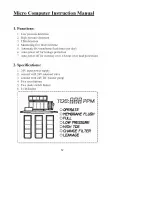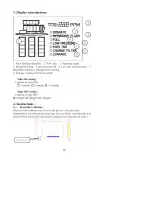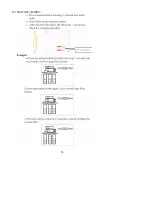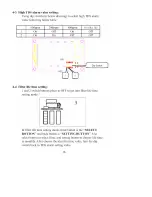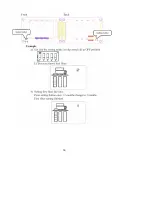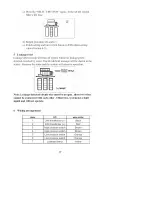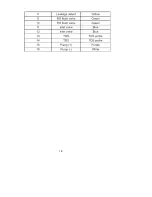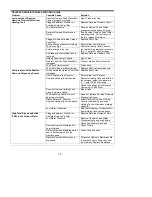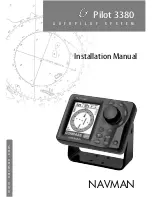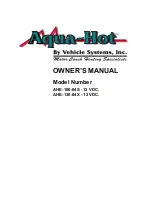
3 ml) into the Reverse Osmosis tubing and
reconnect it to the Tee.
NOTE:
Now is the convenient time to
change the In-Line Reverse Osmosis
Activated Carbon Post Filter.
•
Slowly open the Reverse Osmosis Feed
Water Ball Valve. When water begins
dripping out of the Reverse Osmosis
Dispensing Faucet, in the following order,
close the Faucet and then open the Holding
Tank Valve.
•
Do not open the Reverse Osmosis Faucet
for at least 5 hours.
•
Discard the first three full tanks of water
produced, they will contain chlorine.
5. Slowly open the Reverse Osmosis Feed
Water Ball Valve.
6. When water begins dripping out of the
Reverse Osmosis Faucet, in the
following order, close the Reverse
Osmosis Faucet and open the Reverse
Osmosis Holding Tank Valve. When the
Reverse Osmosis Faucet is first
opened, expect air and carbon fines
(very fine black powder), from the new
Reverse Osmosis Post Filter to be
rinsed out. This is normal for the first
tank of water.
C. Changing the In-Line Reverse Osmosis
Activated Carbon Post Filter
1. Close the Reverse Osmosis Feed Water
Ball Valve by turning fully clockwise.
2. Close the Reverse Osmosis Holding Tank
Valve and then open the Reverse Osmosis
Dispensing Faucet to release the pressure.
3.
Remove the In-Line Reverse Osmosis
Activated Carbon Post Filter. Disconnect
the used Reverse Osmosis Post Filter by
pressing in the connector's collar and at the
same time pulling the tube out of the fitting.
Unscrew the fittings on the In-Line, re-
Teflon tape them and install them on the
new Reverse Osmosis Post Filter. Do not
over tighten the fittings.
4.
Firmly reconnect the polytubes to the new
Post Filter. (Refer to Fig. 5 below.)
REVERSE OSMOSIS TECHNICAL DATA
A. Reverse Osmosis Water Quality
Reverse Osmosis water quality is normally
measured with a TDS meter. The more
dissolved solids in the water, the higher the
conductivity. The results are usually
reported in
Parts per Million
(ppm) or
Milligrams per Liter
(mg/l) of
Total
Dissolved Solids
(TDS). (Although
technically they are not exactly equal, in
most discussions ppm = mg/l).
Reverse Osmosis Membranes are rated by
the amount of dissolved solids that are
rejected. This rating is a ration of the TDS in
the feed water to the TDS in the product
water and is reported as
Percent
Rejection
. If the feed water contained 100
ppm of TDS and the product water
contained 10 ppm of TDS, 90 ppm have
been rejected and the reject ration is 90%.
Percent Rejection =
Feed TDS – Product TDS
Feed TDS
EXAMPLE: Feed water is 500 ppm TDS
and the product water is 75 ppm TDS.
Percent Rejection = 500 – 75 x 100%
500
Percent Rejection = 0.85 x 100% or 85%
Figure 5
IN-LINE REVERSE OSMOSIS
COCONUT SHELL CARBON POST
FILTER ASSEMBLY
In-line Coconut Shell
Carbon Post Filter
IN
OUT
From
tank
To Faucet
11
Summary of Contents for EWR 4050
Page 5: ...BALL...
Page 8: ...LONG REACH FAUCET Figure 2A 6...
Page 14: ...12...
Page 15: ...13...
Page 16: ...14...
Page 17: ...15...
Page 18: ...16...
Page 19: ...17...
Page 20: ...18...
Page 23: ...21 Formatted Bottom 0 5...


